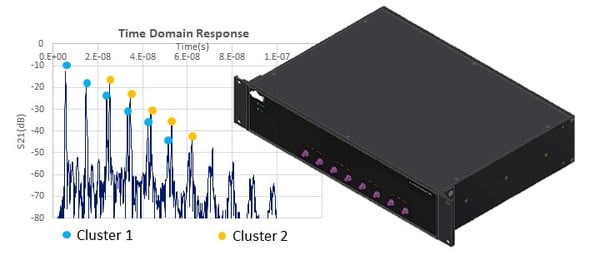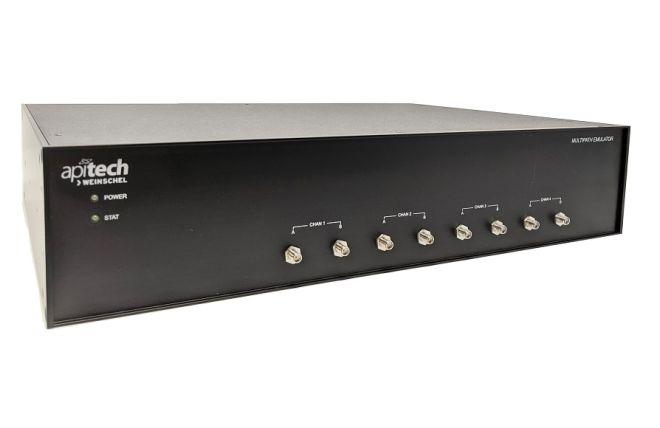Spectrum Control recently launched the Weinschel brand Wi-Fi 6E Multipath Emulator, an integrated programmable subsystem that enables you to test the functionality of Wi-Fi devices in a true multipath environment. The goal with this multipath emulator, and all our wireless RF test solutions, is to ensure that your wireless devices and networks work the first time, every time, and are launched on time and on budget.
The multipath emulator supports Wi-Fi (including Wi-Fi 6E) performance testing, 5G device testing, WiMAX, and 4G.
Hands-on Product Demo
To highlight the functionality and ease of use of the new multipath emulator, Prakash Hari, Product Line Director for Spectrum Control’s programmables and subsystems lines, and Nick Garneski, Engineering Manager, deliver this short hands-on demonstration.
“We co-developed this product with one of the leading Wi-Fi chipset manufacturers to enable them to perform conductive throughput testing of their Wi-Fi devices in a true multiuser MIMO environment,” notes Mr. Hari.
Signal Paths and Software
Spectrum Control’s new Wi-Fi 6E multipath emulator is especially ideal for MU-MIMO conductive testing. Conductive testing is cost-effective and offers a controlled and highly repeatable test environment.
As Mr. Hari remarks in the product demonstration, “consider the Wi-Fi access point you have in your house. The signal transferred from the Wi-Fi access point takes multiple paths to reach your Wi-Fi device. Then your Wi-Fi device needs to be able to distinguish the original signal from the multiple copies that it receives in a multipath environment. The Multipath Emulator creates those multipath conditions by delivering delayed and attenuated versions of the signal.” By providing accuracy and repeatability for your conducted throughput testing, the multipath emulator delivers on our promise of ensuring your wireless devices work each time, every time.
Multipath Emulator Features

The product includes the Wi-Fi 6E Multipath Emulator itself, and the power cord, plus the USB control interface cord. In addition, customers get a CD that includes the software and drivers that are needed to control the multipath emulator. It is simple to set up, use and document.
Product highlights:
- Produces “true” multipath effects, rather than a simulated frequency response
- Best in class insertion loss (13 dB) & roll off between taps (6.5 dB)
- Broadband operation (4.7 to 7.25 GHz; includes the Wi-Fi 6E frequency band)
- Integrated phase shifter to tune frequency response
- Simulates multipath conditions for IEEE 802.11 TGn-A/B Chanel
Simple Set-up, Powerful Results
The multipath emulator has four independent channels. Each channel is bi-directional, allowing you to avoid the use of a circulator or other expensive exterior equipment. Each channel produces two clusters, and each cluster produces an exponentially decaying series of taps, which delivers two multipath conditions. Additionally, each channel has a programmable phase shifter, which can be controlled using an internal table.
As Mr. Garneski shows viewers in our product video, the multipath emulator is typically used in a test system. First, the output of each Wi-Fi access point connects to the input of a multi-channel attenuator such as Spectrum Control’s 4401 series of programmable attenuators. Each output from the multi-channel programmable attenuator connects to the input of a butler matrix, such as the 8401E series manufactured by Spectrum Control’s Weinschel brand. Each output of the butler matrix is equal to the inputs of the boundary matrix combined offset by a fixed phase shift.
The system is bi-directional, allowing you to go in the opposite direction as well.
Conclusion
The design of the Wi-Fi 6E multipath emulator is based on the TGn channel models as detailed in 802.11 specifications.
Wi-Fi 6E is optimized for the newest generation of wireless devices and promises over 1 Gbps speeds. Device makers and service providers seeking to leverage Wi-Fi 6E require effective, repeatable test solutions. This system enables you to simulate conditions found in an indoor Wi-Fi environment. You can measure the throughput of just about any device you can imagine.





